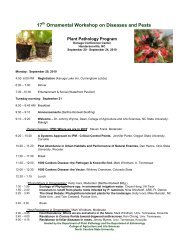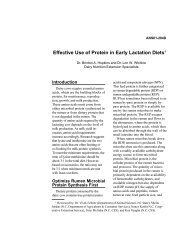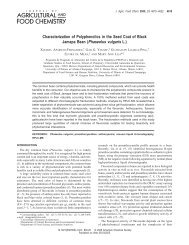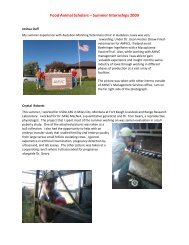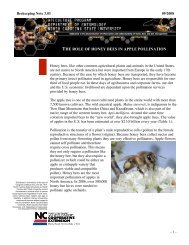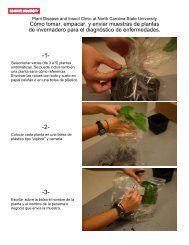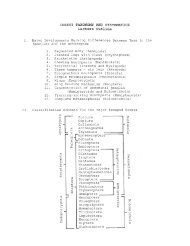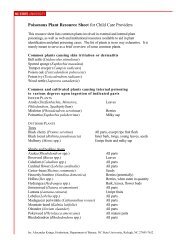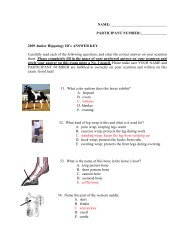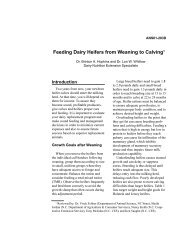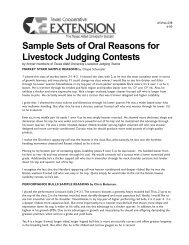2002 Senior Dairy Quiz Bowl Questions Round 05 Phase B 5 ...
2002 Senior Dairy Quiz Bowl Questions Round 05 Phase B 5 ...
2002 Senior Dairy Quiz Bowl Questions Round 05 Phase B 5 ...
Create successful ePaper yourself
Turn your PDF publications into a flip-book with our unique Google optimized e-Paper software.
<strong>2002</strong> <strong>Senior</strong> <strong>Dairy</strong> <strong>Quiz</strong> <strong>Bowl</strong> <strong>Questions</strong> <strong>Round</strong> <strong>05</strong><br />
<strong>Phase</strong> B 5 <strong>Questions</strong> Correct answers are worth 10 points each.<br />
Only the team being asked the questions is to be in the room. Each team will be asked these<br />
5 questions. Answers are to be given by a team captain, but assistance may come from any<br />
team member. A question may be repeated only once. Answers must be started within 20<br />
seconds. Partial credit may be given at the discretion of the judges. After one team has<br />
been questioned, the other team will enter the contest room and be asked the same 5<br />
questions.<br />
1. Which breed of dairy cattle generally produces milk with the highest protein content?<br />
ANS: Jersey<br />
2. Which age group of cattle on a dairy farm generally has the highest incidence of<br />
dystocia?<br />
ANS: Heifers (when giving birth to their first calf)<br />
3. What is the common name for the cattle disease listeriosis, which is most likely caused by<br />
consuming deteriorated silage?<br />
ANS: circling disease<br />
4. On average, how many pounds of body weight per day should Holstein heifers gain from<br />
birth to 24 months of age?<br />
a) 1.8 to 2.0 b) 1.0 to 1.2 c) 2.5 to 3.0 d) 3 to 4<br />
ANS: a) 1.8 to 2.0<br />
5. Which of the following is the most costly form of mastitis?<br />
a) acute b) chronic c) subclinical d) clinical<br />
ANS: c) subclinical<br />
<strong>Phase</strong> C 20 <strong>Questions</strong> Correct answers are worth 15 points each.
Both teams are in the room for <strong>Phase</strong> C. The first contestant to signal will answer the<br />
question within 5 seconds after being acknowledged by the moderator. Failure to do so will<br />
cost that team 10 points. Any contestant answering a question without being acknowledged<br />
by the moderator will lose 10 points. If an answer is incorrect, members of the other team<br />
will have the opportunity to answer the question without having it reread except for<br />
true/false, either or and yes or no type questions. If an answer is given in these types of<br />
questions, the question will be replaced with a tie breaker question, and given to the other<br />
team. No points are deducted for giving an incorrect answer. Team members are not<br />
allowed to discuss the answers in this phase. No partial credit is available in <strong>Phase</strong> C,<br />
except for bonus questions. If neither team can offer an answer to the question within 10<br />
seconds, the moderator will give the answer and the question will be dropped but neither<br />
team will forfeit points.<br />
1. True or False<br />
In dairy cattle, the conception rate generally improves in the summer.<br />
ANS: False<br />
2. Which nutrient do lipases break down?<br />
ANS: Fat (or lipids)<br />
3. Name the stomach compartment in a dairy cow where the lining is covered with papillae<br />
that serve to increase the surface area for absorption of nutrients.<br />
ANS: Rumen<br />
4. Fifty (50) pounds of whole milk should yield about how many pounds of cheese?<br />
ANS: 5<br />
5. When judging dairy cows are the hooks (hipbones) wider or narrower than the pin<br />
bones?<br />
ANS: Wider<br />
6. What happens to “bypass protein” in the rumen?
a) it is degraded<br />
b) it is not degraded and escapes the rumen for absorption at the small intestine<br />
c) it is hydrolyzed<br />
d) it becomes soluble<br />
ANS: b) it is not degraded and escapes the rumen for absorption at the small intestine<br />
7. Which volatile fatty acid produced in the rumen of a dairy cow is a precursor for<br />
glucose?<br />
a) acetate b) propionate c) butyrate<br />
ANS: b) propionate<br />
8. In a dairy cow diet, as the level of fiber increases, what happens to the energy level?<br />
a) it increases b) it decreases c) it stays the same<br />
ANS: b) it decreases<br />
9. True or False<br />
By law, whole milk sold in the grocery store must contain at least 5% milk fat.<br />
ANS: False (3.25% milk fat)<br />
10. What is the name of the condition that occurs in a dairy cow when the pH of the rumen<br />
is very low.<br />
ANS: Acidosis<br />
11. Nutritionally, a low milk fat test is an indication of a deficiency of:<br />
a) fiber b) protein c) energy d) corn grain<br />
ANS: a) fiber<br />
12. Which of the following is a B vitamin:<br />
a) carotene b) niacin c) tyrosine d) threonine<br />
ANS: b) niacin<br />
13. Your veterinarian cultures Mycobacterium paratuberculosis from a cow in your herd.<br />
What disease does the cow have?
ANS: Johne’s disease<br />
14. Which parent determines the sex of a calf?<br />
ANS: The sire<br />
15. Immediately after a calf is born, its navel should be dipped in what solution?<br />
ANS: Tincture of Iodine<br />
16. True or False<br />
<strong>Dairy</strong> calves do not need to be fed hay until they are weaned.<br />
ANS: True<br />
17. What two amino acids are most often considered to be first limiting or co-limiting for<br />
milk protein synthesis?<br />
ANS: Lysine and Methionine<br />
18. True or False<br />
In order to make genetic progress in a trait, the trait must have variation.<br />
ANS: True<br />
19. How many points on the PDCA scorecard are allotted to dairy character?<br />
ANS: 20 Points<br />
20. Gossypol is a chemical compound, found in some feeds, that has been found to be toxic<br />
to some livestock when fed in excess. Name a common dairy feed ingredient that may<br />
contain gossypol.<br />
ANS: Cottonseed meal and Whole cottonseed<br />
Bonus <strong>Questions</strong> Each bonus question is worth 20 points.<br />
Bonus questions may be earned in the toss-up round. To receive a bonus question, 3
different team members must correctly answer the toss-up questions. Bonus questions are<br />
not passed to the other team, nor are points deducted for an incomplete or incorrect<br />
answer to the question. Bonus question will be asked whenever 3 team members have<br />
answered toss-up questions correctly with the count kept individually for both teams<br />
within a match. Eligibility for bonus questions does not carry over to another match. The<br />
answers must come from the team captain but assistance can come from the other team<br />
members. Only the number or answers required by the bonus question will be accepted.<br />
Example: If the bonus has a four-part answer - the first four answers given by the team<br />
will be accepted. Answers to a bonus question must start within 20 seconds and be<br />
completed within 60 seconds.<br />
1. What is lactose?<br />
a) milk protein b) milk fat c) milk sugar<br />
ANS: c) milk sugar<br />
2. What term describes congestion of the udder due to excessive fluid accumulation?<br />
a) metritis b) udder edema c) ketosis d) parturition<br />
ANS: b) udder edema<br />
3. Which compartment of the ruminant stomach is also known as “manyplies” and<br />
functions to squeeze fluid out of the digesta:<br />
a) rumen b) reticulum c) omasum d) abomasum<br />
ANS: c) omasum<br />
4. What is the name of the by-product that results from the cheese manufacturing process?<br />
ANS: Whey<br />
5. When a cow is superovulated and the resulting developing embryos are transferred to<br />
unrelated recipient cows, the calves that are born will be:<br />
a) unrelated b) full siblings c) identical<br />
ANS: b) full siblings



